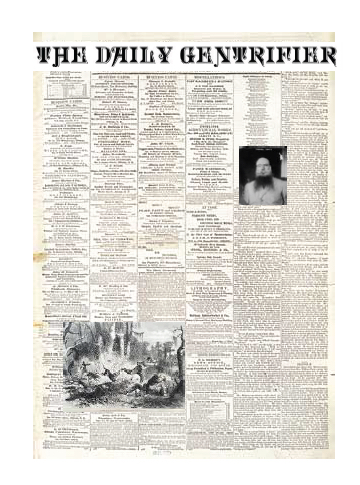The artist and writer Dushko Petrovich was walking home in the Crown Heights neighborhood of Brooklyn, New York, when he thought of a title for a new publication: The Daily Gentrifier. Petrovich had been on the road, doing interviews for Adjunct Commuter Weekly, a magazine he edited and published that catered to the interests of higher education’s growing population of adjunct professors. With The Daily Gentrifier, Petrovich—who is now a tenure-track professor at School of the Art Institute of Chicago and therefore relinquishing the editorial reins of Adjunct Commuter Weekly—will bring his creative focus to the realities of real-estate in the United States, something he feels will be especially urgent in the wake of the 2016 presidential election.
Over the phone Petrovich explained, “I want to take up the aesthetic and ethical positions of gentrification.” Promotional materials for The Daily Gentrifier tout its locally sourced reporting—“slow journalism”—and small typefaces. The forthcoming publication, a two-sided letterpress broadsheet, will also contain reviews of local businesses in the neighborhoods of Crown Heights in Brooklyn, New York, and The Mission in San Francisco, California. A supplement called The Flyover Flyer will accompany The Daily Gentrifier with coverage of events in the Chicago neighborhoods of Logan Square and Pilsen. Needless to say, The Daily Gentrifier will be sustainably sourced and manufactured.
While Adjunct Commuter Weekly addressed adjunct teachers as its primary audience, The Daily Gentrifier will implicate all creative professionals. As Petrovich explained, gentrification is an issue that pertains to the creative class. Artists—this writer and Petrovich included—sometimes settle in postindustrial neighborhoods where cheap housing is available. As the character of a neighborhood shifts and the cost of living there rises, members of the original community are inevitably forced out. The cycle of gentrification points to a systemic problem regarding how real-estate resources are allocated in urban settings and who benefits from them.
“With a racist real-estate mogul as our new commander-in-chief, it’s clear that the politics of gentrification are at the center of national politics,” Petrovich explains in The Daily Gentrifier’s editorial letter. In the first issue, William Powhida, an artist and critic, writes about how the Small Business Jobs Survival Act has endeavored to improve the commercial lease-renewal process in New York City, which directly affects the affordability of studios for many artists. The contribution by the artist Torkwase Dyson, “Ricochet Love,” describes her experience being kicked out of her Bedford-Stuyvesant apartment; she soon found a sympathetic landlord in Fort Greene. In The Flyover Flyer, Anjulie Rao tackles the subject of Chicago’s architecture and its relationship to gentrification in the city. Through these articles and others, The Daily Gentrifier aims to provide multiple perspectives on the unwieldy dimensions of gentrification amid political turmoil.
The Daily Gentrifier will be available in January 2017, at local establishments in the Bedford-Stuyvesant neighborhood of Brooklyn, The Mission in San Francisco, and the Chicago neighborhoods of Logan Square and Pilsen.
Born in Quito, Ecuador, Dushko Petrovich is a Chicago-based artist, writer, editor, and teacher. He received his BA from Yale and his MFA from Boston University before serving as the Starr Scholar at the Royal Academy of Arts in London. Petrovich is a cofounder of the imprint Paper Monument, under which he has co-edited many publications, including I Like Your Work: Art and Etiquette and Draw It With Your Eyes Closed: The Art of the Art Assignment. He also chaired the n+1 Foundation’s board of directors from 2013 to 2015. Petrovich currently teaches in the New Arts Journalism department at the School of the Art Institute Chicago.
Editor’s note: On September 21, 2017, The Daily Gentrifier celebrated its inaugural issue at MoMA/PS1 in conjunction with the New York Art Book Fair.





